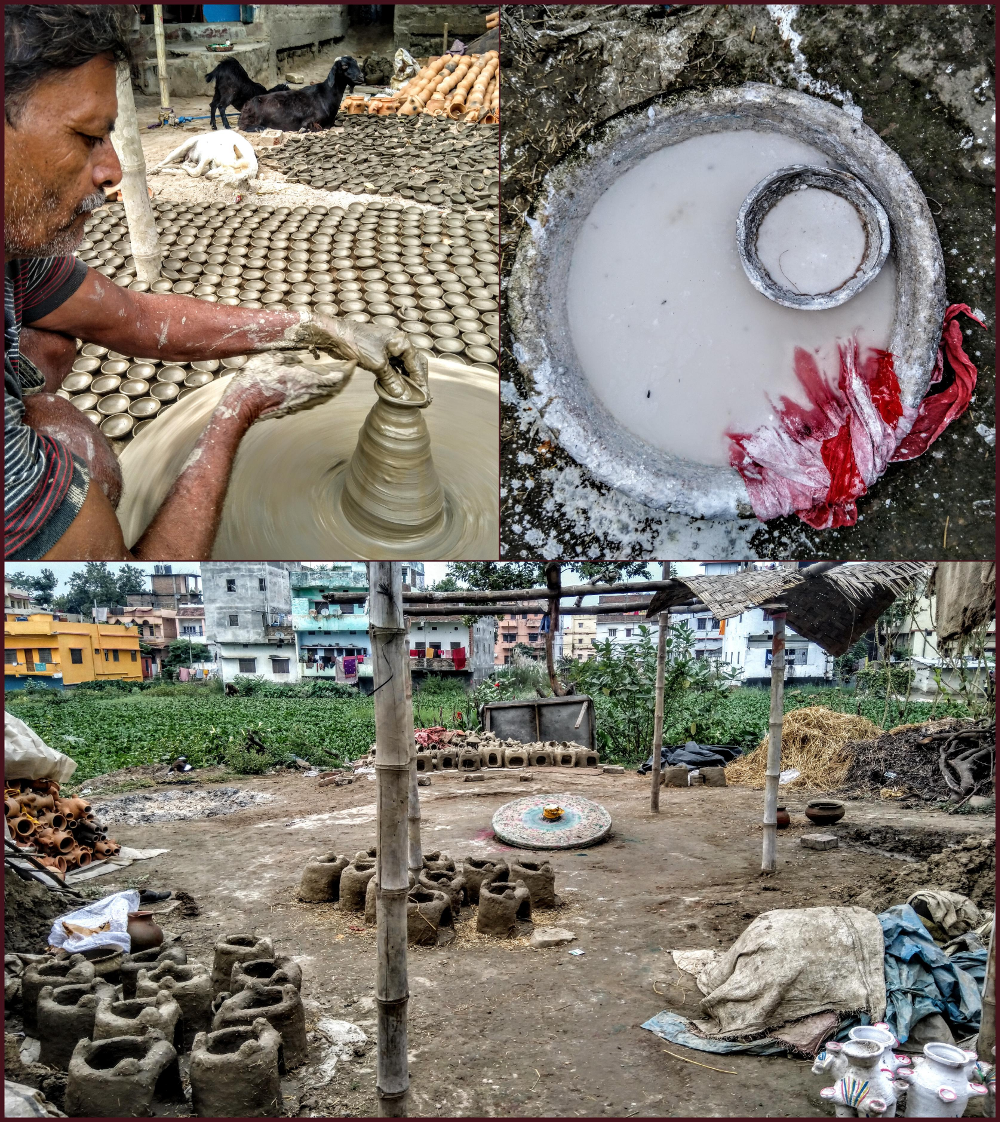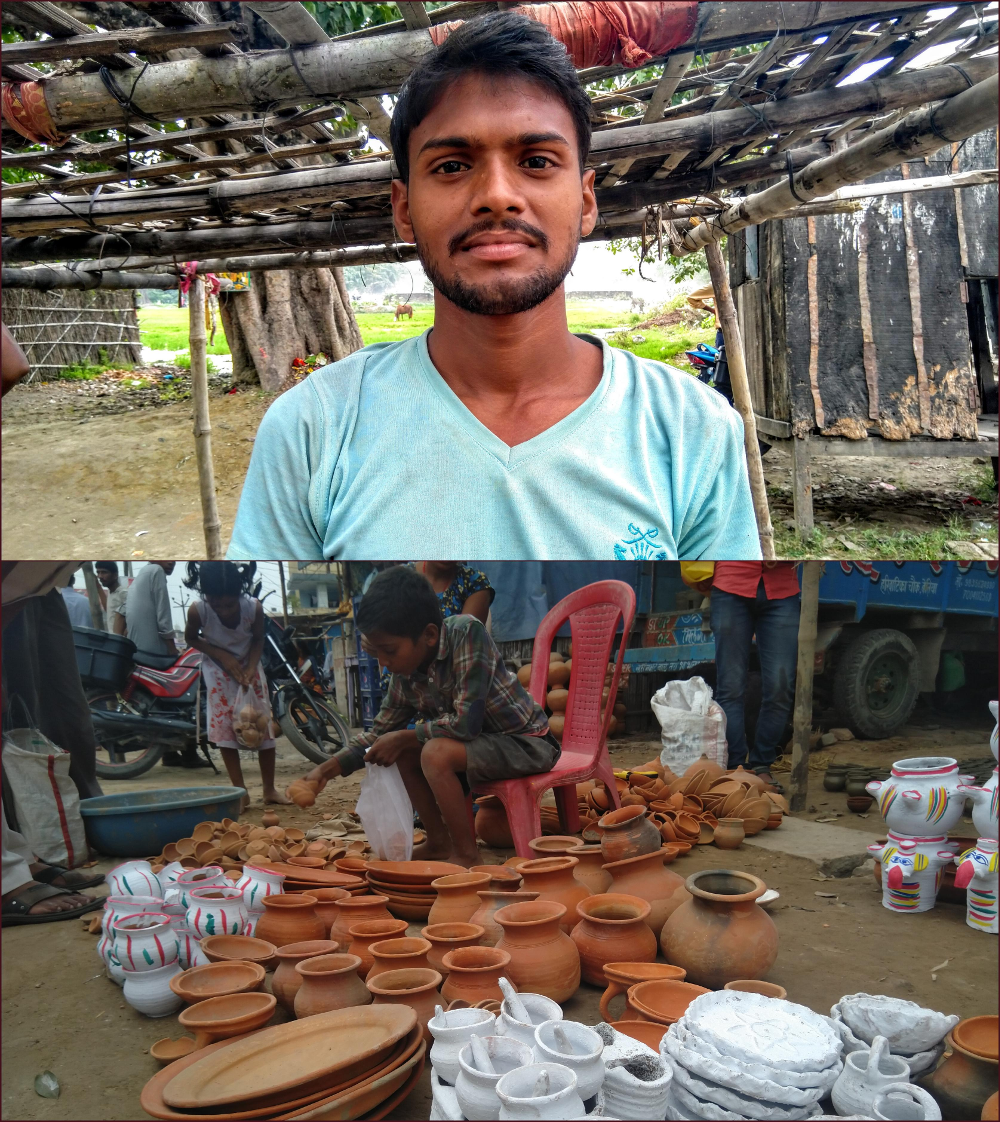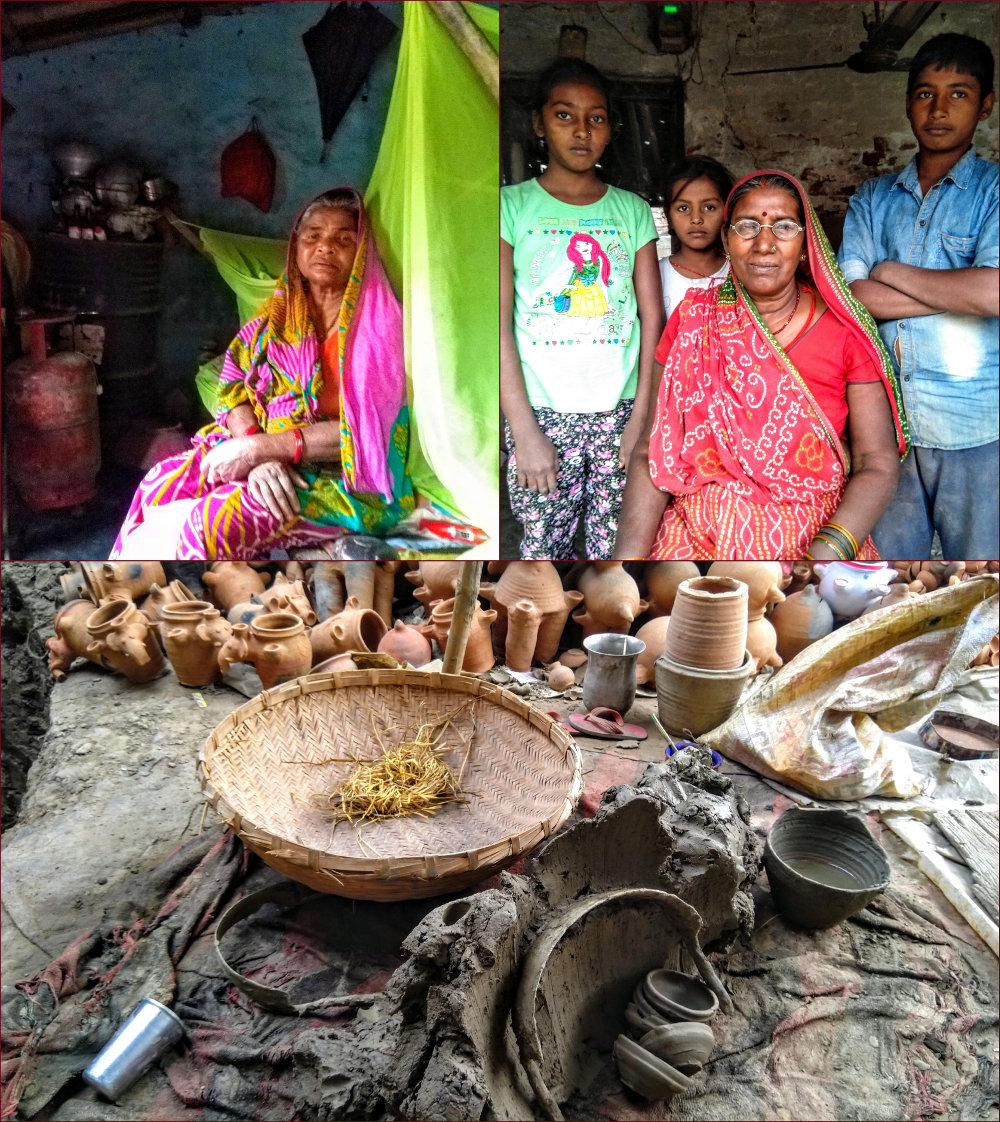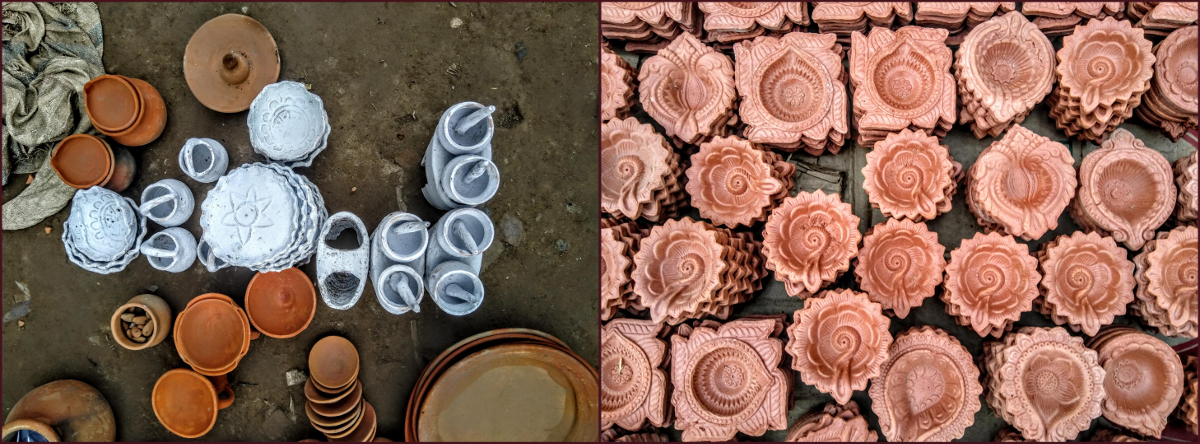“The cost of raw materials used in pottery has fluctuated critically, much more than the selling price of pottery products, therefore, scooping an imbalance in the business,” says a traditional potter from West Champaran.

Jitendra taking out earthen plates [used in Chhath] from kiln.
“Will young people study to get a decent job or get into this,” asks Gangasagar, adding, “Our time was different. We were uneducated and there was no option. With this income, no one can fulfil modern needs. Prices of everyday commodities are catastrophically increasing…”
It is said that the art of pottery is as old as human history. The rarely perishable hard bits of pottery have helped historians solve the puzzles of oldest civilisations. Like clay products, Gangasagar’s family’s descent is too old to trace but it is soon to be a part of history as he says that “the tradition is suffering a huge blow from unsustainable industrialisation and modernisation.”
He tells NewsClick that the cost of raw materials used in pottery has fluctuated critically, much more than the selling price of pottery products, therefore, scooping an imbalance in the business. The prices of Nadiya (earthen curd container), Dhakni (earthen bowl), Kalsa (earthen pot) and Diya or Diyari (earthen lamp) have faced a relatively slow increment. While the items were being previously sold at Rs. 0.5, Rs. 1.5 and Rs. 0.3 respectively; over two decades later, their prices have elevated to just Rs. 1.5, Rs. 5 and Rs. 0.6– they have catered between two-fold and three-fold increase at most.
However, the price of clay, a silica variant, has gone up from Rs. 50 per tractor trolley volume [roughly 10x6x2ft3] to Rs. 3,000. Similarly, cow dung and timber are sold at high rates of Rs. 300 per cubic feet and Rs. 10 per kg, in sharp contrast to two-decades-old corresponding rates of Rs. 50 and Rs. 2.

Gangasagar (top), Bhagmani (bottom right) and Lilawati (bottom left).
Unaware of any government scheme, Gangasagar is coping with the drawbacks of his traditional job. “Some government employee might have visited my shop, Diwali and Chhath (one of the most popular festivals in Bihar) are for all. But no one has suggested me how to advance this business and earn through these pottery skills,” he says, adding that he has taken an informal loan of Rs. 20,000 at a monthly interest rate of 5%. “I pay interest amount consistently, but I do not know how how to get out of this debt,” he adds.
“We have been doing this all the while just to keep this tradition alive. Instead of helping poor like us, Satyendra Kumar, the manager of Bettiah Raj, threatened to evict us. Where could we go? We resisted,” says Bhagmani Devi, Gangasagar’s wife.
Gangasagar’s workshop, the largest workshop in the area, is collaboratively managed by the his family and his late brother Ramsagar Kumar’s family. Ramsagar’s death was unnatural. His family says that one day while he was working on the potter’s wheel in unfavourable weather, he suddenly experienced fits and collapsed. Since then, his wife Lilawati Devi and son Jitendra Pandit are active in this field.
As the workshop has run out of clay, the only hope for them is to sale the remaining merchandise. A Chanpatia-based clay trader has told the potters that clay would be difficult to find. Even if that was accessible, potters would face a hefty bill.
Bhagmani and Lilawati are segregating the offerings—few kilograms of rice, pulse and sarees—made by a regular customer. These gifts are in return for funeral pottery urns the workshop supplied. “But that is sporadic. I get a monthly pension of Rs. 400,” Lilawati says, “after he [referring to husband] left us, I had no choice except to engage Jitendra in this.”
Jitendra works at a nearby retail store and receives Rs. 7,500 per month for 15 hours of daily labour. If he skips, Rs. 250 a day is deducted from his balance. He has temporarily taken a leave from his job; he will re-join after November 3 when Chhath mahaparva concludes.
Both of them are staying together in a joint-family, there are two kuccha homes on an area of 5-dhur. They are yet to receive any benefit of housing scheme.
Gangasagar’s eldest son Dharmendra, 22, is pursuing B.A. in History in local Ram Lakkhan Singh Yadav (RLSY) College. While he was married over a year ago, he still wants to continue education. For him, pottery making is plan B, in case “degree does not help”. “I had to pay a bribe of Rs. 100 to access the government scholarship of Rs. 1,800 in secondary school,” he says talking about the corruption in government schools in the region. He further says that he is eligible for a scholarship of Rs. 7,000 a year, however, no call has been made to him yet. He adds, “I went to the welfare department many times after submitting the completed form, but they keep saying that ‘we will inform you when the list is updated…’.”
Pottery is a source of daily subsistence for at least a hundred people in this region. While Gangasagar’s stall is not in the market area, his relatives have set up their stalls, next to their homes, facing the NH-28B, near the crowded market of Hariwatika Chawk.
Several customers had lined up to bargain in front of the stalls on the occasion of Dhanteras, when this reporter visited the market.
Ramashish, 59, is shaping small earthen lamps by balancing the pressure of his fingers and palms. He is using a concrete potter’s wheel or chhak mounted on a hinge or killa. In fact, none of the potters have motorised wheel. Each potter’s wheel costs Rs. 1,000.

Ramashish (top left), lime powder (top right), clay stoves [used to cook sacred meal of ‘rasiao roti’ in Chhath festival] (bottom) are also up for sale at Lalmati’s stall.
He has to finish the clay lump before Chhoti Diwali (the first day of Diwali). After diyas come out of wheel, they are left to become leather-hard, then the items are layered with hay and taken to the pottery kiln, a traditional bisque firing set-up which utilises cow dung and timber to harden pottery pieces.
Amid his work, Ramashish says, “Festoon bulbs have inundated the market… Earthen lamps are only customary. People get a maximum of few dozen lamps…not more than that. One can imagine how difficult it is for us to continue this practice.”
“And, it is not hidden that at least ten Diyas out of hundred are fractured in the kiln,” he adds, talking about the high error ratio prevalent in the traditional firing method. He has six daughters, the eldest one has recently matriculated but, he has no clue about their future.
It was Ramashish’s grandfather Raghunath Pandit who had come to Bettiah from Varanasi; potters were allotted land by the Maharaja of erstwhile Bettiah Raj. After two generations, he is fearful of the ruthless anti-encroachment drive, as he—like other potters—has extended the workshop on the government property along the road. He is aware that such extensions are adding to the traffic jams on the road, but, there is no other suitable space. Many poor potters have sold their valuable land; thus, being forced to extend their stalls on encroached land. The lack of support and appropriate guidance from the administration is deepening the problems for the poor (and poorly educated) potters.

Dharmendra (top); Hathi, Gullak, toys and Diyas at Ramashish’s stall (bottom).
Ramashish’s mother Kalawati Devi, 75, says that decline of usage of Ramgilas or Kulhad (earthen cups) has mainly affected the business. “As Diyas or Hathi sets are seasonal, our income was primarily dependent on Ramgilas and Khapada [Vertically cut hollow-cylindrically kilned clay item traditionally used to insulate Kuchha roof]. Who drinks in earthen cup nowadays? Also not many people live in kuccha houses today,” she says, adding, “Chukia or Gullak (clay made coin bank) too, has no market-demand.”
Lalmati Devi, a sexagenarian, has knee problems. But that is not stopping Lalmati, a widow, from struggling hard against social constructs to earn a living. Her children have broken ties with her. While her sons live in a three-storey building, she has no option except to live in a small room with thatched roof in the backyard of the building where she has a small workshop. “They got the property transferred in their names. I am illiterate…With remaining savings, I am operating this stall,” she says. She had ordered 1,00,000 Diyas at Rs. 0.35 each.
However, she feels that the wholesale trader cheated her. “I am telling you the truth– they are just 60,000 pieces.” The tractor driver charged Rs. 1,500 for transporting the stock from Raxaul to Bettiah, 50 kms apart.

Lalmati in her kuccha house (top left); Muskan, Sonam, Lalmati and Golu (top right); wedged pliable clay at Ramashish’s workshop
Lalmati has employed nephew Chhotelal Pandit for a daily wage of Rs. 300 to assist her. Chhotelal Pandit, 60, believes that daily wage is better than investing in the production of pottery products. “At least, you know how much you are making at the end of the day (in daily wage work),” says Chhotelal who is partially blind. As he cannot do heavy manual tasks, he can work as a salesman.
Lalmati’s neighbour shares the same name. The neighbour, even though not a widow, shares many problems with her namesake. The starkest among them is the decimation of pottery industry against the backdrop of monopoly of artificial decorative items. She says, “We begin working on Diwali and Chhath items in Bhado mas [coinciding with August month]. After two months of travail and hazardous incessant rains, we end up with a few pennies. Suppose it rains today, then, where will we keep these drying items? They will all be destroyed!”
She also says, “Why have you come here now? Every year reporters come and inquire about the same thing. Despite these all newspaper reports, nothing has changed so far.”
Lalmati’s son Rudal is firing the kiln in the backyard. Her grandchildren are helping her manage the shop. The stall also has Koshis, in addition to diyas and clay made kitchenware-toys. Koshi is a liturgical item used in Chhath festival [commemorated on the sixth day after Diwali]– a set of designed earthen pot, plate and elephant, arranged in a vertical position. Unlike common diyas, Koshis are painted with lime powdered water. Thereafter, leaves or lines of different colours are drawn on them. This year, potters plan to keep a base price of Rs. 100 for a Koshi set. They will be ready to put on public display for sale after Bhaiya Dooj.
None of the potters here have any agricultural land. While they may get heavy payment for their property, no one wants to sell. According to them, this is the last vestige of their ancestors and once vibrant pottery industry.
Sunny Kumar, who studies in 3rd standard in a nearby private school, is learning how to manage pottery shop. Since he is too young for any manual tasks, he sits on the cash counter. “I want to become an engineer,” he says. He has no idea about an engineer’s job, he just heard the ‘term’ somewhere.
Harishchandra Pandit, Sunny’s father, says, “Can this pottery business alone finance you? No. That is why, I became an electrician. I work on a contractual basis.” Harishchandra, 35, has got around 50,000 diyas this year. In off-season, he installs flat electric wiring for Rs. 7,000; he hires three assistant novices for the task. “Wiring of a common apartment [~3/4-BHK] here takes a maximum of seven days,” he adds.

Nagendra will make a profit of Rs. 2 on each terracotta diya. He is hopeful to sell all of them by Chhath.
His brother Nagendra, 30, has come up with an innovative plan. He introduced Bengal’s terracotta diyas in the local market last year. Welcome response from the customers encouraged him to bring around 80,000 diyas this year. He has partnered with a local businessman for this venture. Nagendra lost his father to an unknown medical condition in his early teens, and the only childhood memory he has is of becoming a daily wage labourer. “I do not know how to operate the potter’s wheel. I could not learn it. This trade at least keeps me connected with clay.”
Courtesy: News Click
